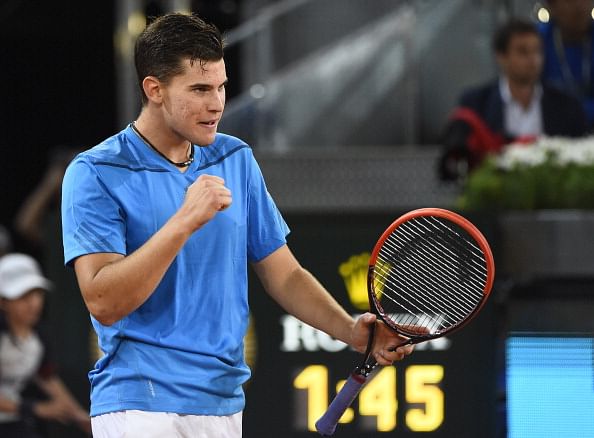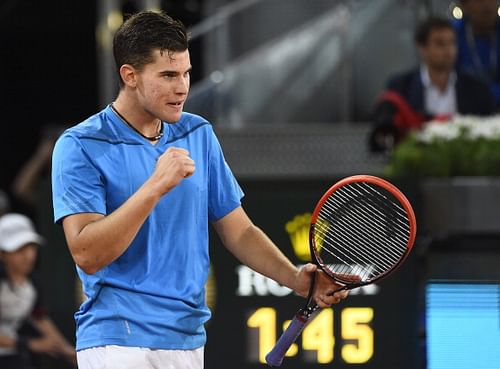
Dominic Thiem: Could he be heading for a future of domination in men's tennis?

Austrian player Dominic Thiem celebrates after winning his men’s singles second round tennis match against Swiss player Stanislas Wawrinka at the Madrid Masters at the Magic Box (Caja Magica) sports complex in Madrid on May 6, 2014.
Before Dominic Thiem played his second round match against Stanislas Wawrinka at the Mutua Madrid Open, he took to Facebook summing up his post-match analytical thoughts about his straight-set win over Dmitry Tursunov in the first round, and how excited he was to play Wawrinka on the Caja Magica. He concluded it with an optimistic fervour to try his best to ‘trouble’ the Swiss, ending the status update with a cheery ‘Vamos.’
Eventually, in his match against Wawrinka the 20-year-old did more than merely trouble the Swiss. He upset him – the most in-form player of this season – 1-6, 6-2, 6-4, despite losing the opening set. It was an inspired performance, the sort that makes everyone takes notice; in Thiem’s case even more so given the list of his professional exploits this year.
Thiem has played qualifying matches in eight tournaments, making it to the main draw in all but one event – at Acapulco. His game’s no doubt impressive, but what’s more, it’s his free-flowing style that catches the eye early on. Solid on both flanks he is, but his tactical acumen is exemplified by his ability to anticipate his opponent’s shot and the way he mixes his shots throughout the course of the match. This tactical feature of his game-plan is more enhanced on clay, a surface that Thiem regards to be his favourite.
One look at his game on clay and its easy to understand why Thiem prefers it. On the surface, the solidity of his game, especially his single-handed backhand, gets more leverage allowing him to have better control over match proceedings. It allows him to rein in his opponent, even if he’s trailing the other man by a few games and points. Alongside his ability to mix up his shots, on the surface Thiem is also able to angle his shots such that his opponents are left far out of position to time their returns well, enabling him to capitalise on such mistimed returns. Complementing all these is Thiem’s unhampered and unrestricted movement on the surface which lends his game a certain deceptive languidness that he further effectively uses to bait his opponents to his advantage.
Another advantage that Thiem has enjoyed this season has been the fruits of his consistency. His consistent performances have been instrumental in propelling his ranking to inside the top-100 – he’s currently ranked 70th – with more ranking ascensions expected after his upset win over Wawrinka.
Thiem’s consistency this year however, is just an extension of his form of last year where he won four titles – at two Challenger events at Casablanca and Kenitra and four Futures events in Italy and Croatia respectively. Alongside these wins, the Austrian also capitalised on the two wild-cards that he received at two ATP 250 events, the Bet-at-Home Cup held at Vienna and Erste Bank Open held at Kitzbühel, making it to the quarter-finals at both tournaments.
Interestingly, all of Thiem’s successes, including his two quarter-final appearances at the ATP tournaments last year, came about on clay – his favoured surface. This one-sidedness – prevalent despite the inherent aptitude he has for the game – in his performance timeline is one aspect Thiem will look at amending, as he evolves as a player. This along with trying to his maintain his fitness for longer lengths of time.
At Madrid, post his win over Wawrinka, Thiem withdrew from his third round match against Feliciano Lopez citing illness (he was suffering from diarrhoea and stomach cramps). Such an occurrence, ill-timed as it was, wasn’t the first time that Thiem was forced to pull out of a tournament mid-way. Last year he withdrew from a Futures event at Croatia in the final and by his own admission, had suffered from a weak immune system during his teenage years that prevented him from sustaining consistent form for long time periods.
Gifted as he is, Thiem’s fitness issues are an encumbrance he could do without. For someone so young, he is well adjusted mentally with his physical stamina and form rarely dipping during matches – an upshot of his regular practice sessions with Ernests Gulbis. But Thiem needs the anchoring of fitness to help him not just bolster his playing reserves, but also to ensure that his consistency doesn’t hit rough patches, interrupting his season untimely, forcing him to become yet another ‘coulda-woulda-shoulda’ statistic the sport churns out, rather than dominate the sport as his potential warrants.